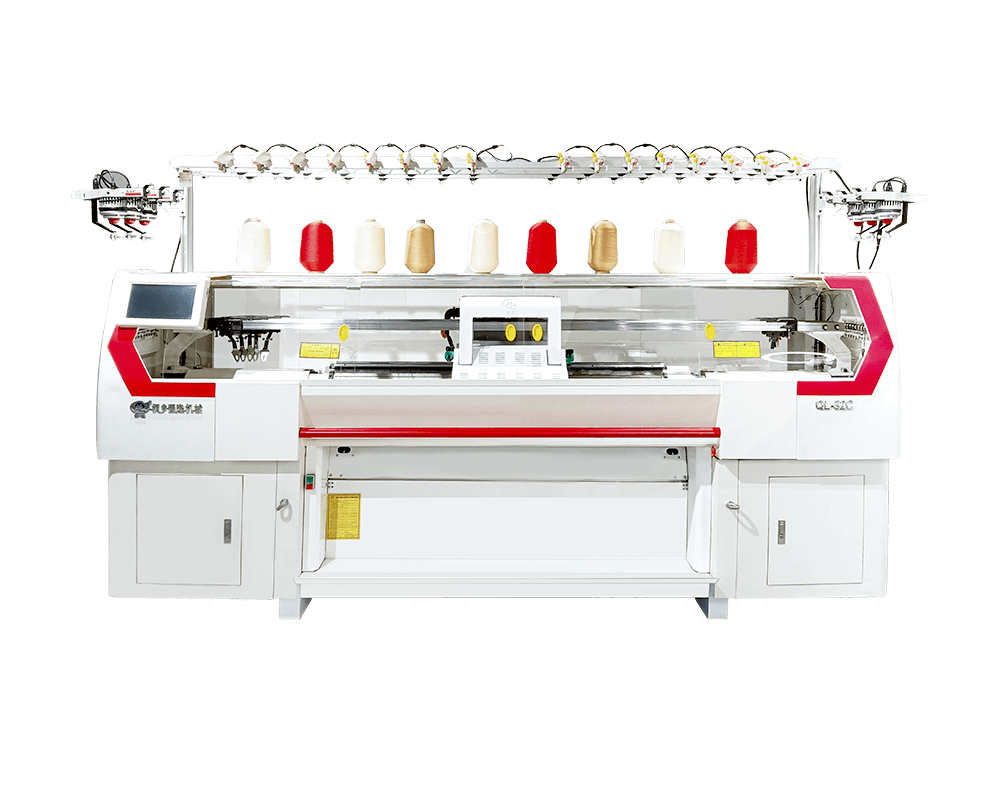Tongxiang Qianglong Machinery Co., Ltd. is high-tech China wholesale computerized flat knitting machine manufacturers, specialized in designing, developing, and manufacturing Knitting Machinery..
Using a whole garment computerized flat knitting machine offers several advantages over traditional knitting methods. These advantages can be particularly appealing to manufacturers and businesses in the textile and fashion industries. Here are some of the key benefits:
Seamless Construction: Whole garment knitting machines can produce garments in one piece without the need for sewing or joining separate panels. This results in seamless garments that are more comfortable to wear and have fewer points of potential weakness.

Reduced Labor Costs: Automation in whole garment knitting reduces the need for manual labor, including cutting, sewing, and finishing. This can significantly lower production costs.
Faster Production: These machines are capable of high-speed knitting, allowing for rapid production of garments. This speed can help businesses respond to changing fashion trends and customer demands more quickly.
Customization: Whole garment knitting machines can easily create customized designs and patterns. This flexibility is especially valuable for producing unique or personalized items.
Material Efficiency: The precise control of these machines minimizes yarn waste. Traditional knitting methods often generate more waste due to the need for excess yarn for seams and allowances.
Reduced Lead Times: Faster production and reduced manual labor mean shorter lead times for bringing products to market.
Consistency: Computerized control ensures uniformity in the knitting process, resulting in consistent product quality.
Complex Designs: Whole garment knitting machines can produce intricate and complex designs with ease, including textured patterns and colorwork.
Sustainability: Reduced material waste, energy-efficient production, and shorter transportation distances (due to faster production) can contribute to a more environmentally friendly manufacturing process.
Cost-Effective Prototyping: Designers and manufacturers can quickly create prototypes and samples, reducing the cost and time associated with traditional prototyping.
Inventory Management: Because these machines can create garments on demand, businesses can minimize the need for large inventories, reducing storage costs and excess stock.
Competitive Advantage: The ability to produce innovative, high-quality, and customized garments sets businesses apart from competitors in the fashion industry.
Less Manual Skill Required: While traditional knitting often requires skilled knitters, operating a whole garment knitting machine primarily involves programming and machine operation, making it more accessible to a wider range of workers.
Scalability: Manufacturers can easily scale production up or down to meet changing demand without significant changes to their production process.
Reduced Error Rates: Automation reduces the likelihood of errors and defects in the knitting process, improving overall product quality.
Ease of Pattern Modification: Patterns and designs can be quickly adjusted and modified in the software, allowing for easy adaptation to changing trends or customer preferences.
It's important to note that while whole garment knitting machines offer many advantages, they also come with their own set of considerations, including the initial investment in machinery and training for operators. However, for many businesses in the textile and fashion industries, the benefits of these machines often outweigh the initial costs, leading to improved efficiency, quality, and competitiveness.
Seamless Construction: Whole garment knitting machines can produce garments in one piece without the need for sewing or joining separate panels. This results in seamless garments that are more comfortable to wear and have fewer points of potential weakness.

Reduced Labor Costs: Automation in whole garment knitting reduces the need for manual labor, including cutting, sewing, and finishing. This can significantly lower production costs.
Faster Production: These machines are capable of high-speed knitting, allowing for rapid production of garments. This speed can help businesses respond to changing fashion trends and customer demands more quickly.
Customization: Whole garment knitting machines can easily create customized designs and patterns. This flexibility is especially valuable for producing unique or personalized items.
Material Efficiency: The precise control of these machines minimizes yarn waste. Traditional knitting methods often generate more waste due to the need for excess yarn for seams and allowances.
Reduced Lead Times: Faster production and reduced manual labor mean shorter lead times for bringing products to market.
Consistency: Computerized control ensures uniformity in the knitting process, resulting in consistent product quality.
Complex Designs: Whole garment knitting machines can produce intricate and complex designs with ease, including textured patterns and colorwork.
Sustainability: Reduced material waste, energy-efficient production, and shorter transportation distances (due to faster production) can contribute to a more environmentally friendly manufacturing process.
Cost-Effective Prototyping: Designers and manufacturers can quickly create prototypes and samples, reducing the cost and time associated with traditional prototyping.
Inventory Management: Because these machines can create garments on demand, businesses can minimize the need for large inventories, reducing storage costs and excess stock.
Competitive Advantage: The ability to produce innovative, high-quality, and customized garments sets businesses apart from competitors in the fashion industry.
Less Manual Skill Required: While traditional knitting often requires skilled knitters, operating a whole garment knitting machine primarily involves programming and machine operation, making it more accessible to a wider range of workers.
Scalability: Manufacturers can easily scale production up or down to meet changing demand without significant changes to their production process.
Reduced Error Rates: Automation reduces the likelihood of errors and defects in the knitting process, improving overall product quality.
Ease of Pattern Modification: Patterns and designs can be quickly adjusted and modified in the software, allowing for easy adaptation to changing trends or customer preferences.
It's important to note that while whole garment knitting machines offer many advantages, they also come with their own set of considerations, including the initial investment in machinery and training for operators. However, for many businesses in the textile and fashion industries, the benefits of these machines often outweigh the initial costs, leading to improved efficiency, quality, and competitiveness.

 English
English 简体中文
简体中文
 Chinese
Chinese English
English











